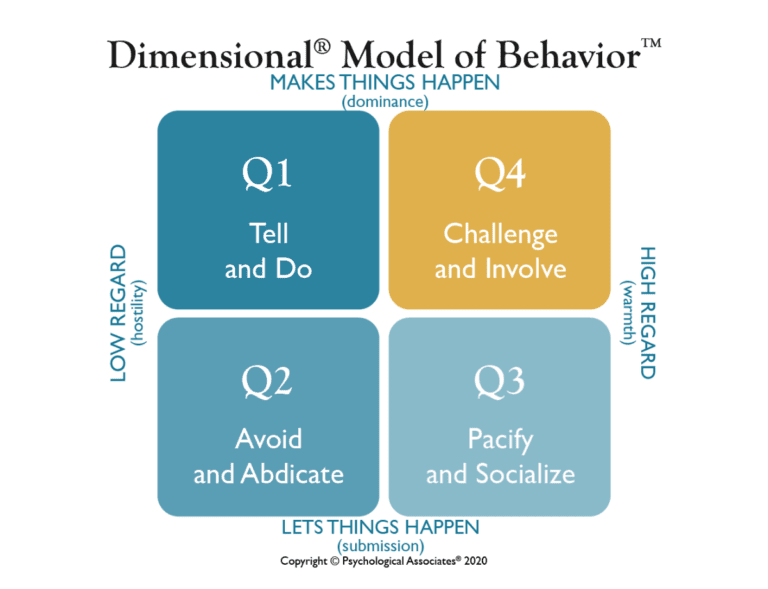Is Q4 Leadership Too Soft?
People who’ve worked with our Dimensional Model of management behavior have either asked this question or heard others ask it: Is Q4 behavior really tough enough? They may agree that Q4 behavior provides real skills for leading, involving, and motivating others. Yet, they worry that the Q4 collaborative leadership style is too soft for them or for the culture where they work.
Before examining Q4’s “toughness,” we need to look at its origin: the Dimensional® Model of Behavior™.
Dimensional Model of Behavior

As you may already know, the Dimensional Model categorizes behavior using two dimensions. The vertical dimension shows action orientation, known as the task continuum; the horizontal dimension shows regard for others, known as the people continuum. When we combine the two dimensions, we get the Model with four quadrants — Q1, Q2, Q3, and Q4 behavior.
The Dimensional Model contributes to our training in a variety of ways. It’s a tool for sizing up the behavior of individuals or groups, a key to identifying another person’s intangible needs, and a system to plan and structure communication for maximum effectiveness.
All of these aspects of the Dimensional Model are important for improving interpersonal interactions; however, the Model also sets a standard, an ideal, for behavior in the workplace. All behavior is not equally effective in producing day-to-day business results, or in creating what Richard Walton, Ed Lawler, and Tom Peters have called a “high-involvement, high-commitment culture.”
This culture is critical for any organization to compete in terms of productivity and quality in the global marketplace.
Whether you export to Istanbul or consult from your kitchen table — whether you are in manufacturing, service, or government — the standards and expectations for your goods and services are set daily in a truly global market. You can’t be the best in productivity, quality, service, and innovation without doing your best to lead, develop, and motivate your human capital.
7 Questions about Q4 Leadership
Q4 behavior gives us the best skills for leading, developing, and motivating people. So, why do we meet resistance to Q4 behavior? Why is there resistance to Q4 as an ideal and as a set of skills for achieving the ideal?
Different individuals ask in different ways, but there are seven basic questions about Q4 and its collaborative leadership style.
1. What if my habits don’t support Q4?
For many managers, becoming more Q4 means replacing behavior they’ve practiced for years with something new that initially feels awkward. But behavior isn’t effective just because it seems natural.
For example, you may have a great natural golf swing. Unfortunately, this natural swing seldom connects with the ball. To become more effective in the game, you had to learn new ways to grip, stand, and swing — all of which felt very awkward at first. Once learned, however, these techniques produced better results.
Learning new skills takes effort and patience — but the resulting increase in effectiveness is well worth it.
2. Is there really one best way to manage?
No, there isn’t. This question assumes that Q4 behavior is a rigid, narrow, unitary set of actions. In fact, the opposite is true — the hallmark of Q4 management is its ability to adapt and flex. It helps managers deal with the diversity of people and situations encountered daily.
When teaching Q4 skills, we spend a lot of time showing managers how to tailor their behavior for maximum effectiveness in dealing with different individuals. No, there’s no one way to do anything — but there’s a better way to do everything as a leader.
3. Doesn’t the Dimensional Model label things as “not okay”?
Remember that the Dimensional Model describes behavior, not people or “styles.” Once we establish this focus on behavior, we don’t hesitate to point out that Q1, Q2, and Q3 behavior all have consequences that can impair leadership and management.
Q1 behavior by a boss kills empowerment; Q2 behavior by a coworker stultifies collaboration; Q3 behavior by a team leader impairs the team’s direction and effectiveness.
Let’s be direct: Behavior that impairs, rather than enhances, the effectiveness of others in the organization is “not okay” — any way you look at it.
4. What if it won’t fit with our current culture?
Scientific management won’t fit, either. Organizations often bring in Dimensional Training® as part of a culture-change initiative. Most of the time, the current culture is not supporting empowerment, innovation, and high commitment. We know that a change towards a more effective culture has to start somewhere that can reach each individual. Q4 skills can begin that change.
5. My boss isn’t Q4 — why should I be?
This question has two sides.
The first says, “My boss isn’t Q4, and look how well he/she has done.” This statement assumes that the boss’s achievements wouldn’t have been even better if Q4 skills were present. It’s difficult to debate this point without a “control” for comparison.
The second side of the question asks, “How can you expect me to be Q4 when my boss isn’t?” Nowhere is it written that you have to pass bad management down. As Peter Drucker has pointed out, leadership is a personal responsibility. You don’t have to get it to provide it.
6. Q4 isn’t tough enough.
OK, Question 6 isn’t a question; it’s a statement. It reflects a common difficulty in interpreting the Model. Often, the problem is confusion between dominance (also called “action orientation”) and hostility. Managers don’t understand that they can be dominant — assertive and dynamic — without being hostile — unresponsive and insensitive.
Often, when managers first try to move from Q1 to Q4, they drop into Q2. Instead of backing off unresponsive behavior, managers back off dominance. Then they feel that to reassert dominance, they have to give up responsiveness to others.
Managers must keep in mind that Q4 action orientation is just as powerful, focused, and persuasive as Q1 dominance. We’ve all heard of deliberate, influential leaders who never have to raise their voices to achieve strong respect and commitment through the involvement of others.
Also remember that there is no more challenging boss than a Q4 boss. Suppose I get Q1, Q2, or Q3 behavior from my boss. In that case, I can always find excuses for my performance (the boss is a jerk, too distant, totally unfocused). But, if my boss clarifies expectations, gives me the freedom to perform, and holds me accountable for my results — in other words, exhibits Q4 behavior — I have nowhere to hide. That’s power!
7. Don’t you have to be Q1 sometimes?
When? What day-to-day situations call for Q1 behavior?
Managers often cite time pressures or crisis situations — then use them to justify daily use of Q1 behavior. They also indicate the misconception that because Q4 is a collaborative management style, they think you need to call a meeting in every situation. Of course, this is absolutely false. Q4 leaders get things done — they couldn’t do that if they had to call a meeting for every decision!
As with Question 6, the real problem is often confusion over appropriate action orientation. After all, almost nobody asks, “Don’t you have to be Q2 (or Q3) sometimes?”
Q1 Behavior is Inconsiderate
We need to consider what Q1 behavior really is. Being action-oriented, forceful, or directive isn’t exclusively Q1. Being inconsiderate is Q1. The distinction between Q4 and Q1 behavior is based on respect and consideration for others, not on action orientation, forcefulness, or directness. No, there aren’t times when you have to be inconsiderate.
Another typical example is the employee who has been told in repeated meetings that a project is due by a specific date. Although the employee has stated commitment in each meeting, the project still hasn’t been done. Isn’t this the time to bring out the Q1 behavior and lay everything on the line?
Another common example is the employee who has been told in repeated meetings that a project is due by a specific date. Although the employee has stated commitment in each meeting, the project still hasn’t been done. Isn’t this the time to bring out the Q1 behavior and lay everything on the line?
In this situation, it’s definitely time to spell out the consequences for the employee. But even that can be handled in a Q4 manner.
Think back to the Dimensional Model. You can climb higher on the task continuum without moving from right to left on the people continuum. Another way to think about it is that there is no need to demean another person to increase your action orientation, forcefulness, and directness.
The Cost of Q1 Behavior
One of the highest costs of Q1 behavior goes beyond the frustration and resentment it creates. Q1 behavior on your part suppresses the development of the very skills your people need most — how to solve their own problems, make their own decisions, and develop their own internal accountability for excellence. That’s a high price to pay for “being Q1 sometimes.”
Conclusion: Is Q4 Leadership Tough Enough?
Let’s finish where we began. Q4 behavior is qualitatively superior to Q1, Q2, or Q3 behavior in producing a management culture of excellence. Q4 skills give you and your people a solid foundation for leadership. Don’t be Q4 because it’s nice — be Q4 because it works. It’s hard to be more pragmatic than that.












